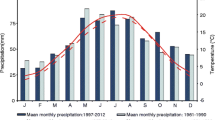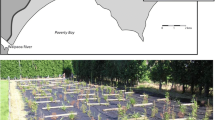Abstract
The Chinese tallow tree (Sapium sebiferum Roxb.) is a rapid-growing species that has become naturalized along the Gulf and southern Atlantic coasts. The tree is particularly well adapted to poorly-drained and saline soils. Chinese tallow seedlings planted at 2’×2’ spacing produced over 5 dry tons of biomass/acre at the end of the second growing season while the biomass accumulation on coppiced plots was more than 7 dry tons /acre at the end of the second year. The Chinese tallow tree has considerable promise as a woody biomass species in the southern coastal regions of the United States.
Similar content being viewed by others
Literature Cited
Ek, A. R., and D. H. Dawson. 1976. Yields on intensively grownPopulus: Actual and projected. U.S.D.A. Forest Serv. Tech. Rpt. NC-21, North Central Forest Exp. Sta., St. Paul, MN.
Hunt, K. W. 1947. Charleston woody flora. Amer. Midl. Naturalist 37: 670–786.
Jamieson, G. S., and R. S. McKinney. 1938. Stillingia oil. Oil and Soap 15: 295–296.
Sokal, R. R., and F. J. Rohlf. 1969. Biometry: The Principles and Practices of Statistics in Biological Research. Freeman, San Francisco, CA.
Author information
Authors and Affiliations
Rights and permissions
About this article
Cite this article
Scheld, H.W., Cowles, J.R. Woody biomass potential of the Chinese tallow tree. Econ Bot 35, 391–397 (1981). https://doi.org/10.1007/BF02858589
Received:
Accepted:
Issue Date:
DOI: https://doi.org/10.1007/BF02858589




